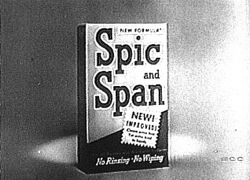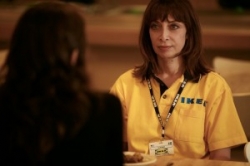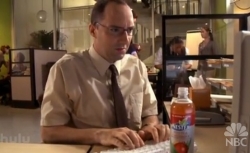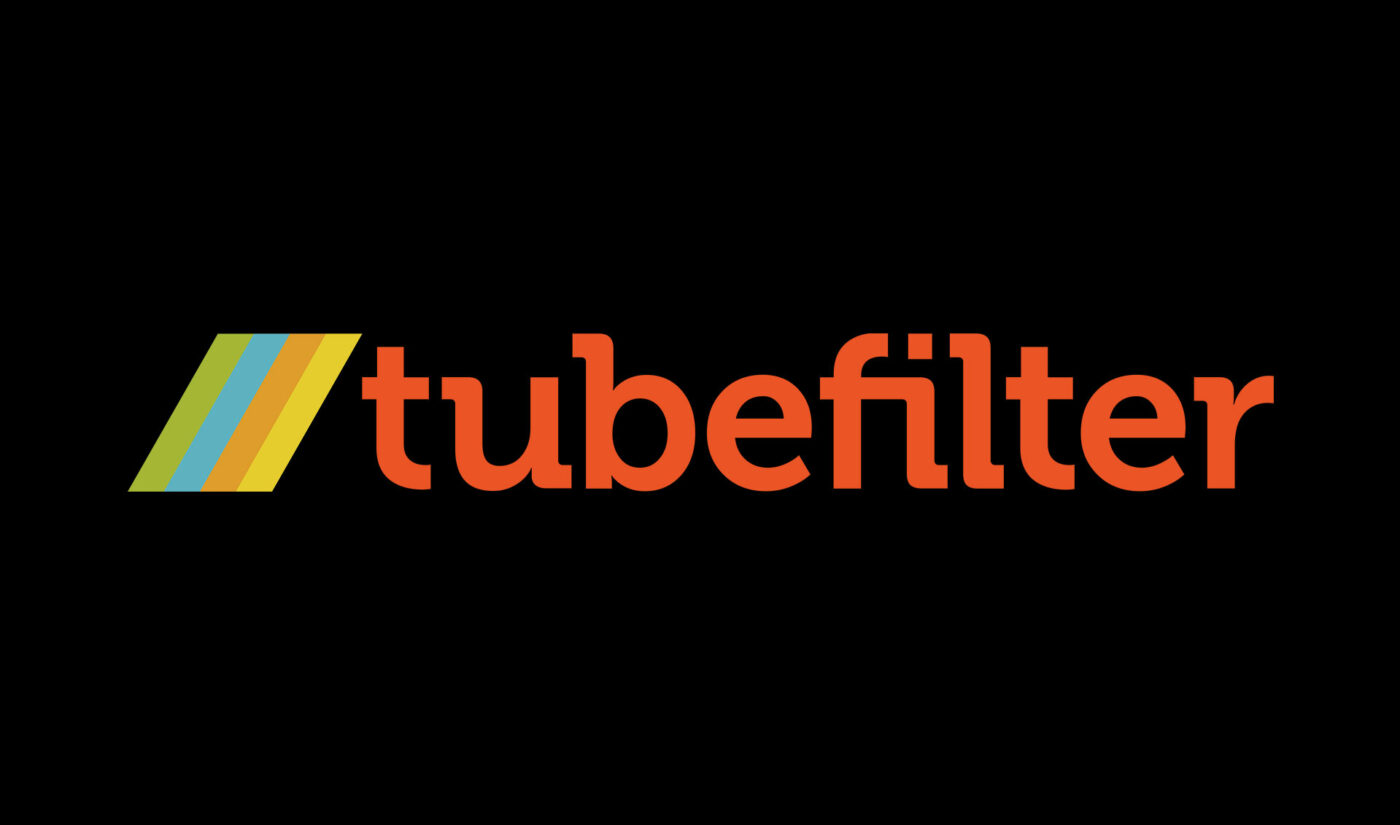 We love our buzz words in the digital world. There was ‘social media’ and ‘microblogging’ and ‘user generated content’ and ‘engagement’ and ‘web 2.0’ (which paved way to the 2.0 suffix attached to everything) and ‘the cloud’… and now there’s ‘branded entertainment.’
We love our buzz words in the digital world. There was ‘social media’ and ‘microblogging’ and ‘user generated content’ and ‘engagement’ and ‘web 2.0’ (which paved way to the 2.0 suffix attached to everything) and ‘the cloud’… and now there’s ‘branded entertainment.’
The thing is, branded entertainment is nothing new. Over 50 years ago, those crafty soap companies figured out that to get in front of women to peddle their household products, they’d need to wrap their advertising around some meaningful content. And so was born the soap opera.
But while the concept isn’t new, the delivery method is. Unlike the push method of traditional tube TV, blanketing messages across a broad audience, technology has enabled us to deliver compelling, resonant experiences in an interactive format. Through the one-to-one properties of the web, we can reach users directly and craft relevant messaging that builds relationships and drives brand loyalty. New media brings us endless possibilities for taking branded entertainment to the next level, and harnessing the tools to turn a static ad into a dynamic experience.

Subscribe for daily Tubefilter Top Stories
To help crystallize this concept, we reached out to three pioneers who are helping to shape branded experiences that are as entertaining as they are effective. The four of us will give you our definitions of the various forms of branded entertainment in a roundtable discussion, along with our visions for the future of the space.
Roundtable Participants:
Justine Bateman – Partner, FM78.tv
Tim Jones – COO, Animax Entertainment
Gennefer Snowfield – CEO, Space Truffles Entertainment
Warren Tomlin – President, Fuel Industries
Question 1: How do you define branded entertainment?
 Justine Bateman: To me, branded entertainment is something borne of a Sponsor themselves or their ad agency. It may be a concept they have created fully and hire others to execute or it may be an idea they hire others to create. Nonetheless, the results are primarily focused on the brand vs. a story narrative that minimally involves the brand. Sometimes these pieces appear to be extended commercials.
Justine Bateman: To me, branded entertainment is something borne of a Sponsor themselves or their ad agency. It may be a concept they have created fully and hire others to execute or it may be an idea they hire others to create. Nonetheless, the results are primarily focused on the brand vs. a story narrative that minimally involves the brand. Sometimes these pieces appear to be extended commercials.
 Tim Jones: In the broadest sense, you could argue that all entertainment is branded. However, as it pertains to our Branded Entertainment division at Animax, we define the term to mean any content (linear video, game, app, widget or interactive experience) that incorporates a brand or a brand message within its context. Animax recently produced a branded entertainment series for CKE (Carl’s Jr. and Hardees) entitled SLOTCAR. This 8-episode comedy series which targeted young hungry males went beyond incorporating products and logos and integrated the brand within the storylines of the series. For example, Episode 01 introduces us to the driver of the new Hardees car: Smokey, a black bear from Tennessee.
Tim Jones: In the broadest sense, you could argue that all entertainment is branded. However, as it pertains to our Branded Entertainment division at Animax, we define the term to mean any content (linear video, game, app, widget or interactive experience) that incorporates a brand or a brand message within its context. Animax recently produced a branded entertainment series for CKE (Carl’s Jr. and Hardees) entitled SLOTCAR. This 8-episode comedy series which targeted young hungry males went beyond incorporating products and logos and integrated the brand within the storylines of the series. For example, Episode 01 introduces us to the driver of the new Hardees car: Smokey, a black bear from Tennessee.
 Gennefer Snowfield: I see branded entertainment as scripted content that visually depicts the personality and core values of the brand through lifestyle triggers emblematic of the audience it serves. It should communicate the essence of the brand in a way that is both entertaining and personally relevant to consumers. In that manner, viewers relate to the message through the personification of those brand traits rather than pushing empty features and benefits at them as you would in a traditional TV spot. I always say that consumers remember what they feel, not what they hear, and people will always tune out when you try to tell them something. So, branded entertainment allows you to build a contextual backdrop around your brand that engenders an emotional response while still communicating underlying key messages. A perfect example of this in action is Shredded Wheat’s “The Palace of Light” series that, while could be described as merely a longer form commercial, humorously conveys the brand’s rich history and tradition (and without even realizing it, you’ll see that you take away core brand messages like the fact that shredded wheat hasn’t changed in a 100 years without once feeling like you’re being ‘sold’).
Gennefer Snowfield: I see branded entertainment as scripted content that visually depicts the personality and core values of the brand through lifestyle triggers emblematic of the audience it serves. It should communicate the essence of the brand in a way that is both entertaining and personally relevant to consumers. In that manner, viewers relate to the message through the personification of those brand traits rather than pushing empty features and benefits at them as you would in a traditional TV spot. I always say that consumers remember what they feel, not what they hear, and people will always tune out when you try to tell them something. So, branded entertainment allows you to build a contextual backdrop around your brand that engenders an emotional response while still communicating underlying key messages. A perfect example of this in action is Shredded Wheat’s “The Palace of Light” series that, while could be described as merely a longer form commercial, humorously conveys the brand’s rich history and tradition (and without even realizing it, you’ll see that you take away core brand messages like the fact that shredded wheat hasn’t changed in a 100 years without once feeling like you’re being ‘sold’).
 Warren Tomlin: Branded entertainment for us has always been about making the ‘entertainment’ part come first. It’s more than slapping a Fresca logo on the star’s backpack in a TV series; it’s about taking the brand’s identity and spirit and building content that reflects that. Branding isn’t something that needs to be hidden, but if it’s integrated in a way that detracts from the piece of entertainment, then the content fails, and the consumer walks away feeling cheap. Essentially, the adage applies: ‘if you notice it, it’s bad, but if you don’t, it’s worthless’. But more and more, transparency is key. Consumers are smart, and they know brands’ motives—so if the movie scene is good enough, they won’t care if happening at a Kinko’s. It’s well known, but Harold and Kumar go to White Castle is still something of a gold standard in the industry.
Warren Tomlin: Branded entertainment for us has always been about making the ‘entertainment’ part come first. It’s more than slapping a Fresca logo on the star’s backpack in a TV series; it’s about taking the brand’s identity and spirit and building content that reflects that. Branding isn’t something that needs to be hidden, but if it’s integrated in a way that detracts from the piece of entertainment, then the content fails, and the consumer walks away feeling cheap. Essentially, the adage applies: ‘if you notice it, it’s bad, but if you don’t, it’s worthless’. But more and more, transparency is key. Consumers are smart, and they know brands’ motives—so if the movie scene is good enough, they won’t care if happening at a Kinko’s. It’s well known, but Harold and Kumar go to White Castle is still something of a gold standard in the industry.
Question 2: How do you define product placement?
Bateman: Product placement is often where a product is put on camera, often for a previously agreed length of time, in exchange for a fee. This has become commonplace in Old Media and audiences have shown to have a decreased tolerance for this. Much of the time, the product has nothing to do with contents of the scene underway. Example: Will Smith throwing Dasani vending machines in the film, Hancock.
Jones: Product placement is simply when a logo or product is incorporated within entertainment content, like Elliot leaving a trail of Reese’s Pieces for E.T.
Snowfield: Product placement is just that – placing a product directly (often, overtly) into an entertainment experience (TV, film, or game). Two examples that I reference as product placement done well are both from over a decade ago. The first is Golden Eye where BMW is used as an integrated element for introducing their new 328i model, which boasted a hefty uptick in sales post-film. Apple followed a similar strategy the following year by featuring its PowerBook in Mission Impossible. Neither of these placements seemed heavy handed, however, (even though they were prominently featured) because it was believable that James Bond would be driving the latest luxury BMW vehicle, and that special agent Ethan Hunt would have a sleek, advanced laptop (and it certainly doesn’t hurt that Tom Cruise’s character saved the day thanks to his trusty PowerBook). Apple sought to position their brand as the provider of that innovative technology, and even capitalized on the placement in their advertising efforts.
There are hundreds of other notable examples as well such as Pepsi and Back to the Future, Reese’s Pieces and E.T., and FedEx in Castaway. But perhaps the most blatant, and prime example of brand integration that seems forced, and lacking in substance, is Taco Bell’s larger than life presence in Demolition Man, where according to Sandra Bullock’s character, ‘… after the franchise wars, all restaurants became Taco Bell.’ You could have conceivably inserted any brand into that placement; it didn’t communicate any value within the entertainment context that translated back to tangible brand attributes. It was just a gratuitous brand play, much like the recent throw in of Entenmann’s and Zune in Weeds. Those types of disconnected placements disrupt the experience and dilute the story overall, in which case neither brand nor content succeed. Product placement is not about randomly tossing your products into scenes, but aligning your brand with stories that resonate with the people who would buy them. The new Subaru WRX placements in SyFy’s Eureka make sense from that standpoint in that it’s plausible Jo’s character would drive a WRX and is congruent with Subaru’s positioning around forward-thinking features and performance.
Tomlin: Smart product placement takes a product’s intended use and demographic and wraps them into a piece of content in a way that doesn’t smell tacked on. The most important aspect is that it be a natural integration; the product needs to feel like a genuine part of the narrative. If you’re going to put a Volvo in a movie, it should have an opportunity to demonstrate its brand principles, such as keeping the hero of the movie alive in a crash. A great example is the Volkswagen integration into the Bourne movie, where it keeps the bad guy safe in a car chase. It’s funny how much something like the Wayne’s World scene poking fun at product placement can resonate with the industry, but I think since the late 90’s, brands in general have gotten a lot smarter about how and where they plug their content. This clip from Best in Show illustrates how both brands and writers can have fun with placement:
Question 3: How would you define sponsored content or the new concept of sponsor-funded scripted content that Justin Bateman and her crew at FM78 are pioneering?
Bateman: [Me and my team at FM78 created this concept because] funding scripted content is one of the best ways a Sponsor can spend their advertising dollars right now. Our business model includes many benefits for Sponsors and audiences alike, but two of those elements are very ORGANIC product integration where the brand or product is part of the plot or part of the characters’ lives (and not just something sitting on a table in a scene) and an incredible press/publicity campaign wherein the Sponsor would be spoken of during all our interviews and appearances with great appreciation. This would include The Today Show, Letterman, People magazine, NY Times, etc; all the major players in the Traditional press. The press campaign alone gives the Sponsors about $6.4 million of exposure before the show is even launched and that’s just if ONE of our actors is participating. If a Sponsor wants their brand in front of people and wants it out there in a way that endears the audience to them and doesn’t turn them off or make them feel like they are being hard-sold, funding scripted content is the way to go. The audience recognizes that the Sponsor is giving them a gift of a well-done, engaging, entertaining show in exchange for their attention. They are not going to be tricked into watching an ad. They are going to be treated with respect.
Jones: We are all used to receiving sponsor-supported entertainment. The :30-second ad on network television is the classic example. Brand messages are delivered during advertising breaks, but the two are at arm’s length of each other. Sponsored content reduces the space between entertainment and brand message.
Snowfield: FM78’s sponsor-funded scripted content model offers the brand greater flexibility in reaching consumers in a memorable way; however, it requires them to relinquish the control that they’re used to and allow content creators to develop narratives that are lifestyle-centric vs. brand focused. Meaning that the brand must essentially take a backseat and allow the entertainment experience to take center stage. The result is that the brand becomes the benefactor of an experience that respects the audience and delivers something of value to them without any associated corporate hard sell. And where viewers are grateful to the brand who bankrolled that experience vs. put off by being forced to sit through, in what many cases, turns out to be nothing more than a glorified infomercial for the company. The best example of this is IKEA’s Easy to Assemble series, the premise of which is that Illeana Douglas is having a tough time finding work so she’s forced to take a job at IKEA. So, it makes sense that it would be set in an IKEA store, and the entertainment value creates a positive association with the brand while subtly communicating core brand traits, such as simplicity, as the star-studded cast seeks refuge through some everyday normalcy. Without actually saying it, IKEA demonstrates how it fits into consumers’ lives and effectively asserts the tenets of the brand — uncomplicated, everyday quality, customer service-oriented etc.
Tomlin: FM78 is a logical extension of the idea that consumers don’t fear branding, but they do demand more for their attention. In a way, it blends the classic era of live on-air branding with the more subtle and integrated approaches of contemporary branded entertainment, and wraps it all in a tongue-in-cheek package—a tone that consumers are more willing to interact with. We’ll see content getting edgier, quirkier, and in turn, we’ll see brands getting more flexible with their brand positions for the sake of creating great content that consumers will line up to interact with.
Question 4: Where do you think is the overlap between these concepts?
 Bateman: It is possible to have comprehensive overlap of these three concepts. The right players have to be involved. To begin with, the concept for the show has to be a solid one and not some nebulous outline of an idea that people hope will be filled in later. You must have great writers involved who will create a compelling narrative. (This has been true in Old Media for decades and it’s still true today.) The rest of the creative team has to be of top level as well. Your actors, director, editor, website builders, etc should be talented and dedicated to turning in their best work yet. THE INTERNET IS NOT A “SIDE PROJECT; it’s your next job upon which people will judge your work. This is not a time to work with people who are not taking this seriously. Next, the Sponsor has to have faith in this model and has to understand that creating expanded commercials can turn audiences off. Even if the concept is borne of the Sponsor (branded content), the Sponsor must have enough trust of the content creators to allow the story narrative to take precedent over mentions of the brand. Thirdly, there may be deals cut after the initial funding from the main sponsor (with that main sponsor’s permission) to include product placement from other sponsors. Again, we feel very strongly that these product placements MUST be organic and fit naturally into the plot and/or these characters’ lives. If it is not, it turns the audience off of not only the product, but of the show itself as you risk pulling them out of the story they’re watching.
Bateman: It is possible to have comprehensive overlap of these three concepts. The right players have to be involved. To begin with, the concept for the show has to be a solid one and not some nebulous outline of an idea that people hope will be filled in later. You must have great writers involved who will create a compelling narrative. (This has been true in Old Media for decades and it’s still true today.) The rest of the creative team has to be of top level as well. Your actors, director, editor, website builders, etc should be talented and dedicated to turning in their best work yet. THE INTERNET IS NOT A “SIDE PROJECT; it’s your next job upon which people will judge your work. This is not a time to work with people who are not taking this seriously. Next, the Sponsor has to have faith in this model and has to understand that creating expanded commercials can turn audiences off. Even if the concept is borne of the Sponsor (branded content), the Sponsor must have enough trust of the content creators to allow the story narrative to take precedent over mentions of the brand. Thirdly, there may be deals cut after the initial funding from the main sponsor (with that main sponsor’s permission) to include product placement from other sponsors. Again, we feel very strongly that these product placements MUST be organic and fit naturally into the plot and/or these characters’ lives. If it is not, it turns the audience off of not only the product, but of the show itself as you risk pulling them out of the story they’re watching.
Jones: Branded entertainment is nothing new and there have been any number of combinations and examples done in radio, TV and film for many years. There really is no “one size fits all” model. The brand goals and needs, distribution channels and type of content need to be analyzed and matched with the audience to make the optimal choices.
Snowfield: I think the overlap between these concepts centers around authenticity. Brands are an integral part of our everyday lives, and there’s nothing wrong with brands advertising their products or attempting to get their messages in front of consumers. In an oversaturated market where brands are all vying for the same share of voice, they must find creative avenues to rise above the clutter and reach their desired audience. Branded entertainment experiences give sponsors a vehicle for drawing consumers into a narrative where they can define brands in relation to their own lives, and connect on a deeper level than they ever could through overly produced ad spots and pithy taglines — especially in an age where TiVo and other DVRs have virtually eliminated commercial interruption. The key is not to try to sell consumers or usurp content to push product messages, but give them a venue that takes them out of advertising mode and wraps the brand in a meaningful experience where the characters and storylines are the embodiment of brand values. Whether you’re developing a branded entertainment campaign or integrating your product into scripted content, it must be organic to the characters who are portraying it and authentically represent the lifestyle of those who are watching it. When all is said and done, people don’t buy products, they buy the promise of the impact a brand will have on their lives. And what better way to convey that than through an evocative entertainment experience that genuinely reflects what your brand stands for and what your customers strive for? i.e. Don’t tell me the car goes 0-60 MPH; let me experience the roaring sounds of the engine and the thrill of watching the rubber meet the road. In some ways, sponsored content is just a new twist on experiential marketing where entertainment is the experience.
Tomlin: The lines between branded and ‘ad-free’ content will blur as brands and creators become more comfortable with the emerging freedoms of branded entertainment, and let the old rules fall away. The made-for-web approach allows valuable creative experimentation to happen that is crucial for understanding how far brands can go before consumers call them out. Eventually, that confidence and freedom will translate to multiple platforms.
Question 5: What do you think is the sweet spot for brands and content creators to partner on these types of initiatives?
Bateman: I really hope that Content Creators and Sponsors alike can recognize the Pioneer Moment that exists right now. Few generations get to have a Pioneer Moment and unbelievably, we get one. The biggest shift in Entertainment since the beginning of Film is here and those that can recognize this have a unique opportunity to actually design this moment. We will create the new business models that others will need to follow and Sponsors who get involved now will not only get to craft deals that suit their purposes (instead of following what their competitors design), but will go down in the history books as having been forerunners at this juncture. It’s a truly great way to wisely spend advertising dollars and distinguish your brand at the same time.
 Jones: Again, I’m not sure there is one sweet spot for brands and content creators. Every campaign is different, and so the sweet spot for one brand or content creator could be a disaster for someone else. I think new media offers the most opportunity for growth in branded entertainment. Brands are looking to reach audiences in non-traditional ways and to personalize their messages based on individual preferences, making new media (online, mobile, social networks, etc.) more appealing. Likewise, audiences aren’t content to lean back and passively receive these messages — they want to add their own voice, personalize their experiences and take part in a conversation. Therefore, online interactive experiences which integrate brands into compelling content in meaningful ways will be more effective than, say, a banner ad. When it comes to new media content, brands we’re talking to aren’t satisfied with passive product placement . They want to be part of the story.
Jones: Again, I’m not sure there is one sweet spot for brands and content creators. Every campaign is different, and so the sweet spot for one brand or content creator could be a disaster for someone else. I think new media offers the most opportunity for growth in branded entertainment. Brands are looking to reach audiences in non-traditional ways and to personalize their messages based on individual preferences, making new media (online, mobile, social networks, etc.) more appealing. Likewise, audiences aren’t content to lean back and passively receive these messages — they want to add their own voice, personalize their experiences and take part in a conversation. Therefore, online interactive experiences which integrate brands into compelling content in meaningful ways will be more effective than, say, a banner ad. When it comes to new media content, brands we’re talking to aren’t satisfied with passive product placement . They want to be part of the story.
Snowfield: While I’m not averse to organic brand integration, I believe that the sweetest spot for brands and content creators to partner effectively is on companion content that augments the entertainment experience and leaves the narrative in tact. Far too often, sponsors try to retrofit their products into a storyline. Instead, a brand could sponsor a web series, and rather than force their product into scenes a la NBC’s CTRL with a bottle of Nestea blatantly hijacking the content, they could create added value vignettes that expand the lexicon of the story and bring the characters to life. In that scenario, any brand messaging or inclusion is welcome because the brand is giving viewers more of what they want through a deeper backstory, extended scenes, character interaction, etc. I also think this is where multi-platform experiences will bridge the divide between advertising and entertainment by engaging consumers at the point of consumption with immersive experiences that become vivid, exciting and life-enhancing… where viewers are focused intently on the content and the brand who delivered it. Who wouldn’t want to adopt a brand that gives them more of what they want and enjoy? Then, in essence, by supporting that brand, consumers know they will get more of the content they crave. And that’s a pretty compelling brand proposition.
Tomlin: The magic nexus for brands and content isn’t too hard to find, but achieving that perfect balance takes work. Could NBC’s Chuck work at an actual Best Buy instead of a ‘Buy More’? Sure, but it only works for both parties if the brand is open to presenting itself in unusual contexts, and if the writers (and you’ll need good writers) are willing to frame their creative ideas in a way that keeps the brand’s position in mind. A sweet spot on one of our recent projects: Vans wanted to tap into the mobile market, so we built an iPhone skateboarding game with Vans products built into it, which actually made the experience a lot more authentic for players.
In Brands We Trust…
The four of us seemed to overlap on most of our thoughts on the differences between branded entertainment and product placement, and especially around the fact that authenticity of execution is critical above all else or it diminishes the integrity of both the brand and the content. But I think there is some room for interpretation on how best to integrate a brand into an entertainment experience.
The core issue is that the advertising paradigm must evolve to better harness the tools technology offers in reaching consumers on a personal level with content and experiences that resonate personally with them. One of the main reasons this year’s upfronts were so poor is because digital technologies and viewer consumption have changed, and the models that worked before don’t any longer. Nor will consumers tolerate brands who force products into their favorite shows or repackage ads as entertainment – especially when there are so many alternatives.
In a world where even the lines of real life and fiction are starting to blur though 3-D and augmented reality technologies, brands and content must work together to create holistic experiences that extend beyond the :30-second spot – and even beyond the delivery platform itself – to form an emotional bond with viewers. Brands and content creators must also realize that old rules no longer apply. They need each other. Content creators need brand sponsors to bring their vision to life and fund a quality production, and brands need content creators to substantively connect with consumers. But none of those things can be achieved without trust. And nothing influences consumer behavior more than an experience that moves them – and a brand they can believe in.
 Gennefer is a writer, producer and CEO of Space Truffles Entertainment, a boutique digital strategy shop specializing in branded entertainment, web series promotion and immersive transmedia narratives that extend the brand experience through custom multi-platform content. A new media strategist and advisor, Gennefer is considered a thought leader in branded entertainment and speaks on topics ranging from digital storytelling to augmented reality. With over a decade in traditional and web marketing, Gennefer develops compelling brand encounters and multimedia experiences that are changing the face of interactive entertainment.
Gennefer is a writer, producer and CEO of Space Truffles Entertainment, a boutique digital strategy shop specializing in branded entertainment, web series promotion and immersive transmedia narratives that extend the brand experience through custom multi-platform content. A new media strategist and advisor, Gennefer is considered a thought leader in branded entertainment and speaks on topics ranging from digital storytelling to augmented reality. With over a decade in traditional and web marketing, Gennefer develops compelling brand encounters and multimedia experiences that are changing the face of interactive entertainment.








